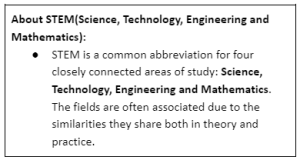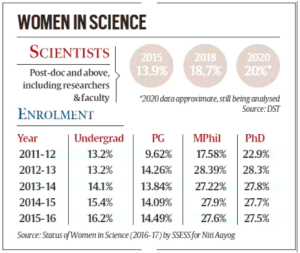
Context:
The Prime Minister recently highlighted the significant contributions of female scientists and engineers towards the Chandrayaan-3 mission.
More about the news:
- For the first time in India’s history, a space mission is being led by two women scientists of Indian Space Research Organisation (ISRO).
- More than 100 women played a direct and significant role in making soft-landing on the lunar south pole possible.
- Some important women scientists include:
- Missile Woman of India: Dr. Dr Tessy Thomas
- Rocket Woman of India: Ritu Karidhal
- Deputy Project Director of Chandrayaan-3 Kalpana K
- Status of women in STEM: Department of Science and Technology (DST)Report:
 Global status: As per the recent Global Gender Gap Report 2023 by the World Economic Forum, women account for 27% of India’s STEM workforce, as compared to 32% of the non-STEM workforce.
Global status: As per the recent Global Gender Gap Report 2023 by the World Economic Forum, women account for 27% of India’s STEM workforce, as compared to 32% of the non-STEM workforce.- Women in Research projects: As per World Bank data, only 33% of researchers are women worldwide
- Women in engineering and technology: Women account for just 22% of professionals working in artificial intelligence and 28% of engineering graduates.
- Gender gap in STEM Education: Globally, 18 percent of girls in higher-level education are pursuing STEM studies, compared with 35 percent of boys.
Enroll now for UPSC Online Course
Significance of Women Participation in STEM:
-
- Economic growth: Women’s participation in STEM fields could spur economic growth and promote gender equality worldwide.
- A study from McKinsey found that with equal workforce distribution, India could increase its GDP by 10%.
- Gender Diversity: Involving more women and girls in science can help create a more diverse and inclusive scientific community.
- Targeted interventions: When women and other traditionally underrepresented groups are involved in the design and execution of scientific studies, the results are likely to be more relevant to them and their communities.
- Inclusivity: Including women and girls in science helps ensure that the resulting knowledge is reflective of the needs of society as a whole, not just those of one group.
- Improved decision making: Different perspectives of females can bring valuable insights and advancements to scientific research and discovery leading to better problem-solving and decision-making.
- Achieving SDGs: STEM is crucial to achieve the UN’s Sustainable Development Goal(SDG) 5 (gender equality) which includes women’s use of enabling technology.
- Reasons behind under- representation of women in STEM:
- Masculine culture: This is due to stereotyping that men are fitter for certain jobs and skills than women, and that women are more ‘delicate’, ‘tender’ and thus unfit for ‘hard’ jobs.
- Paucity of female role models: There are not enough female role models whom women may admire and follow. (Of the 866 Nobel winners so far, only 53 have gone to women).
- Gender gap in self-efficacy: The situation generates concerns among girls and women about their suitability only for certain “soft” fields and professions leading to self-doubt.
- Self-doubt among women professionals: It limits them from applying for leadership roles.
- Challenges of Marriage and family planning: It leads to delay in the involvement of women at the doctoral levels.
- Those who manage to overcome these hurdles often find themselves isolated as they stand out in predominantly male fields, where biases are prevalent and gaining recognition is a continual challenge.
- Burden of dual responsibilities: Women are expected to manage both home and work, for which they require more flexible schedules.
- If there is a career break for personal reasons, it can become almost impossible for women to resume their careers in STEM.
- Systemic Issues: The under-representation of women in STEM starts from school and results from deep-rooted social discrimination, social norms, biases that influence the quality of education they receive and the subjects they study.
- Government initiatives:
- Science, Technology and Innovation (STI) policy of DST: It is targeting 30 per cent women’s participation in science and technology by 2030.
- Currently, 35 of the 97 scientists in DST are women and 11 of 18 divisions are headed by them i.e., 61 per cent of women in leadership.
- Indo-US Fellowship for Women in STEMM (Science, Technology, Engineering, Mathematics & Medicine): It encourages women scientists and technologists to undertake international collaborative research in premier institutions in the USA.
- Vigyan Jyoti: It encourages meritorious girl students of Class 9-12 to pursue education and career in science and technology, particularly in the areas where women are underrepresented.
- Gender Advancement for Transforming Institutions (GATI): It aims to transform institutions for a more gender-sensitive approach and inclusiveness with the ultimate goal to improve gender equity in S&T.
- KIRAN (Knowledge Involvement in Research Advancement through Nurturing): To encourage women scientists through various programmes in the field of Science and Technology (S&T).
- ‘Women Scientist Scheme (WOS)’ under KIRAN provides career opportunities including fellowships to unemployed women scientists and technologists, especially those who had a break in career, for pursuing research in frontier areas of science and engineering.
- CURIE initiative of DST: ‘Consolidation of University Research through Innovation and Excellence in Women Universities (CURIE)’ Programme of DST provides support for development of research infrastructure in women universities to encourage women’s participation in R&D activities.
- Way Forward:
- Redefining the culture in STEM: Mandatory representation of women in Boards, massive rollout of women-centric mentoring programs, flexible or remote work setups, and providing childcare and after-school support.
- Investment in women only institutions: They provide the best platform to address many issues that concern women.
- The Women’s Technology Park started in universities attracted rural women eager to learn and it helped young and bright women to start early on through internships and apprentices.
- Paid Internships: Each state, particularly in rural areas, must encourage girl science students through paid internships or monthly stipends.
- Gender-diversity dividend in STEM: It involves systemic social and psychological changes like introducing young women to incredible STEM role models and ensuring that women in the field are widely represented and appreciated.
- The work culture at ISRO has played a significant role in promoting the potential of women scientists.
- Creative programs: Establishing creative programs to hire, retain, and promote women can help to achieve better gender balance in STEM.
- For instance, organizations like Uber have employee resource groups, mentorship programs, and other initiatives to invest in young women professionals developing careers in technology.
- Indusface, which not only has a woman co-founder but also places a strong emphasis on hiring women in the workforce. This helps to maintain a current female ratio of 25% to 30%.
- Mentoring and funding: Mentoring system and financial resources are needed for those seeking to reenter the workforce after a break.
- Positive parenting: This will help change stereotypical perceptions related to STEM subjects and inspire young girls to choose and work in this area.
News Source: The Hindu
![]() 29 Aug 2023
29 Aug 2023

 Global status: As per the recent Global Gender Gap Report 2023 by the World Economic Forum, women account for 27% of India’s STEM workforce, as compared to 32% of the non-STEM workforce.
Global status: As per the recent Global Gender Gap Report 2023 by the World Economic Forum, women account for 27% of India’s STEM workforce, as compared to 32% of the non-STEM workforce.